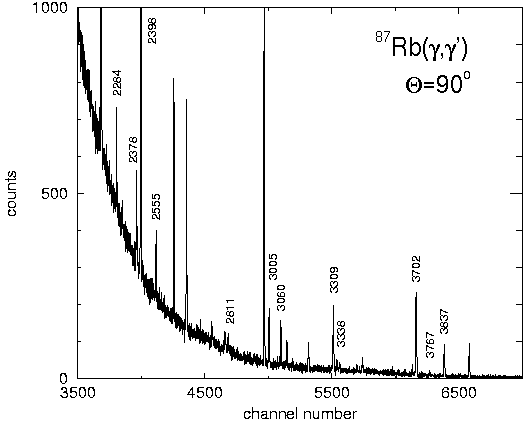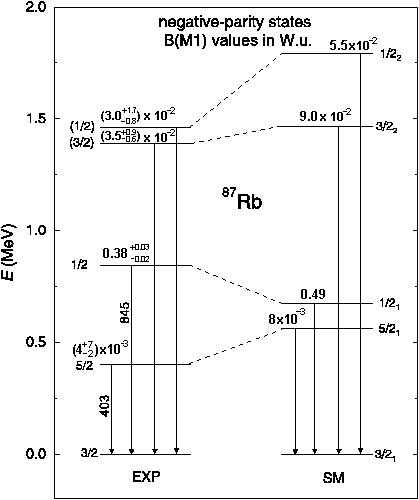| The First Nuclear Resonance Fluorescence Experiment on 87Rb D,H | |||
|---|---|---|---|
| L. Käubler, K.D. Schilling, R. Schwengner, D. Belic1, P. v. Brentano2, F. Dönau, C. Fransen2, E. Grosse, U. Kneissl1, C. Kohstall1 A. Linnemann2, P. Matschinsky2, A. Nord1, N. Pietralla2, H.H. Pitz1, M. Scheck1, F. Stedile1 and V. Werner2 | |||
|
As a result of nuclear resonance investigations of N=50 nuclei [1,2] the question arises to what extent neutron degrees of freedom play a role in the structure of low-spin states in such semi-magic nuclei. Moreover, nothing is known up to now about the response of the N=50 nucleus 87Rb to real photons. The first (g,g¢) experiment on 87Rb was performed with bremsstrahlung of an endpoint energy of 4.0 MeV delivered by the Dynamitron at Stuttgart. Gamma-rays scattered on a 2.507 g 87Rb2CO3 target (87Rb enriched to 99.2 %) were measured with three HPGe detectors of 100 % relative efficiency. In Fig. 1 a portion of a g-ray spectrum is shown.

Fig. 1 g-ray spectrum of 87Rb. Peaks denoted by their g-ray energy belong to 87Rb.
Fig. 2 Experimental results
for magnetic dipole excitations
compared the results of
large-scale shell model calculations.
The width G of 20 states could be measured for the first time. For ten levels for the first time g-deexcitation was observed and for five for the first time g-branchings. All observed states are dipole excitations, twelve of them M1 and six E1 excitations. For the 845 and 3837 keV transitions very large B(M1) and B(E1) values have been found, respectively. Shell model calculations [3] for 87Rb have been performed. The shell model reproduces the right ordering of the experimentally observed magnetic dipole excitations and gives a fair reproduction of the excitation energies. There is a remarkable agreement of the measured B(M1) values with the calculated values (Fig. 2). The very strong 845 keV transition is the proton p1/2®p3/2 spin-flip transition. Dominating proton p3/2, f5/2 and p1/2 single particle character is found for the g.s., the 403 keV and 845 keV states, respectively. The other magnetic dipole excitations are dominated by three protons. Almost all negative parity states contain to some percent contributions of excitations of the N=50 neutron core. Even our large scale shell model calculations considering also the breakup of the N=50 core are not able to describe the electric dipole excitations.
1 Institut für Strahlenphysik, Universität Stuttgart, 70569
Stuttgart
References
[1]J. Reif et al., Nucl. Phys. A 620 (1997) 1
[2]L. Käubler et al., Eur. Phys. J. A 7 (2000) 15
[3]E.A. Stefanova et al., Phys. Rev. C 62 (2000) 054314
|
